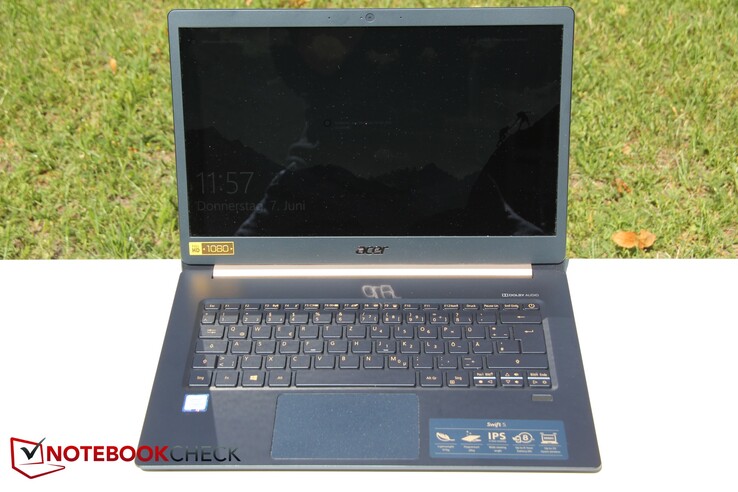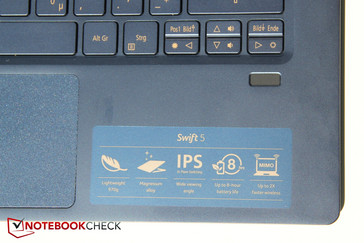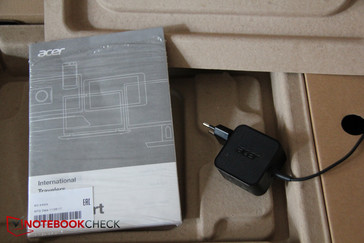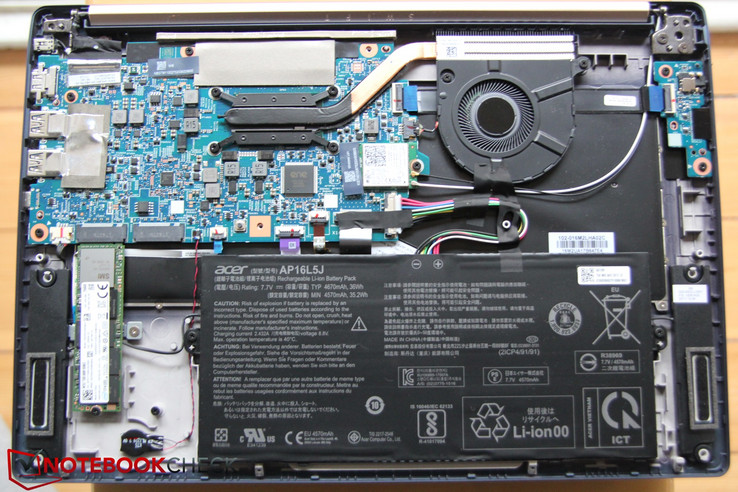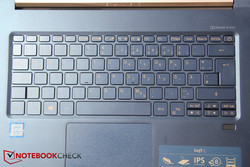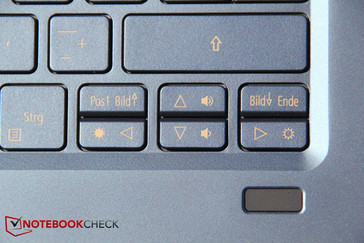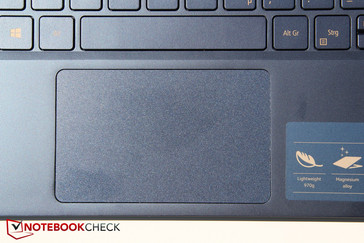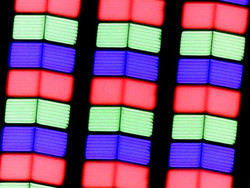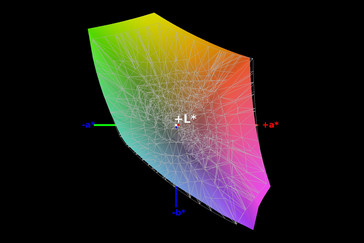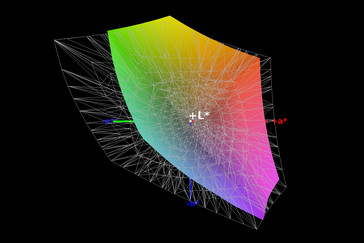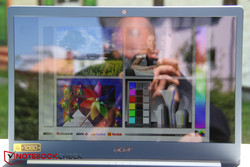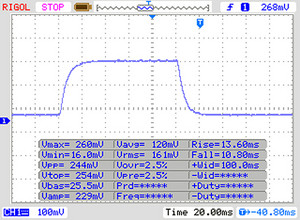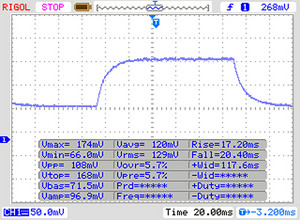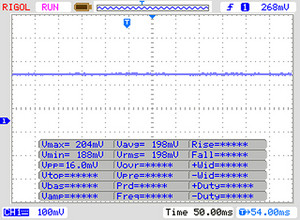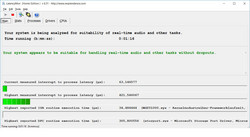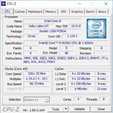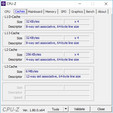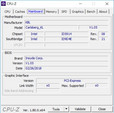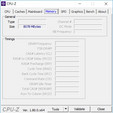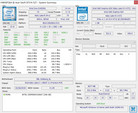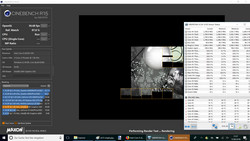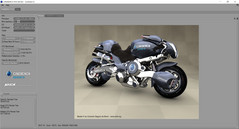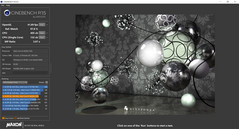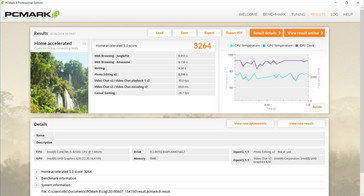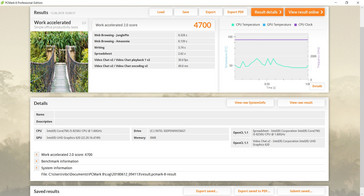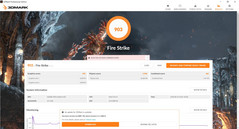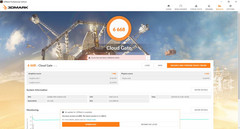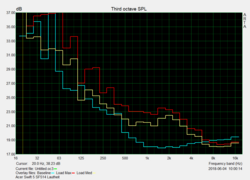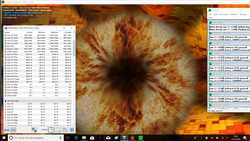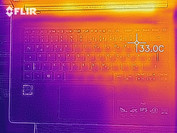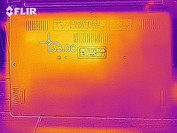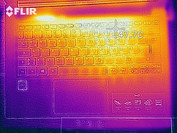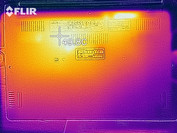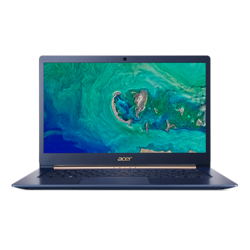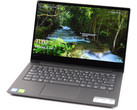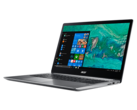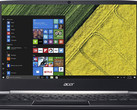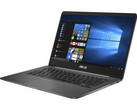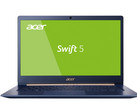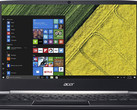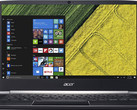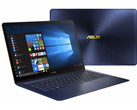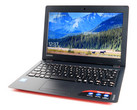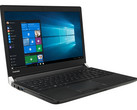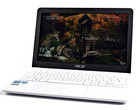Acer Swift 5 SF514 (i5-8250U, UHD 620) Laptop Review

Several models of Acer’s Swift 5 have been upgraded with Intel’s latest Kaby Lake Refresh processors in the course of this year. As we speak, Acer is selling a total of four different 8th generation Swift 5 SKUs. Today, we take a closer look at the Swift 5 SF514-52T-59HY - an ultralight 14-inch laptop equipped with Intel’s Core i5-8250U, 8 GB of RAM, and a 256 GB NVMe SSD. One of its highlights is undoubtedly the FHD touchscreen. Last year, we had its Kaby Lake-equipped predecessor in review (Core i5-7200U). With almost identical hardware, it was a whopping 400 g (0.9 lb) heavier. Let us see what else has changed.
It was surprisingly hard for us to find worthy competitors for today’s review unit as lightweight (aka less than 1 kg/~2.2 lb) 14-inch notebooks with touchscreen are almost impossible to find. Accordingly, we have had to widen our scope to include the Toshiba Tecra X40-D (equipped with a touchscreen), the Asus ZenBook 3 Deluxe UX490UA (similar weight and hardware), the more expensive Lenovo ThinkPad X1 Carbon 2017 (see Asus), and its smaller brother the Acer Swift 3 SF314.
Case
At first glance the Swift 5 - not to be confused with the Acer Spin 5 - looks like any other business notebook: it is completely black save for the golden hinge and an Acer logo on the display lid. The case seems to be of high quality as the inner frame has been largely coated by a thin layer of Magnesium-Lithium and feels very sturdy. We found plastic only around the inner display frame. The very wide golden hinge displaying the Swift logo is an eye-catcher. Apart from that, the case design, including the functional and pragmatic keyboard layout is rather plain and simple. Unlike on many other Swift notebooks, the fingerprint reader is located on the right-hand side below the keyboard.
Unfortunately, that first impression of sturdiness quickly gave way to disappointment once we started warping and bending the case. Even the base creaked noticeably and the display snapped so violently that for a second we feared for its dear life. A second test led to less fearful creaking and snapping, and it is possible that our review unit had to “snap shut” first. Nevertheless, we were able to almost crack the lid open with nothing but our fingernails around the corners of the display; definitely a negative when it comes to build quality.
On a more positive note, the notebook features a 180-degree hinge mechanism. The hinge was very stiff and we found no evidence of teetering while using the device. There is no maintenance hatch at the bottom, and the battery is not user-replaceable.
In terms of weight, the new Swift is the unchallenged leader of the pack. Even its closest competitors made by Asus and Lenovo were around 200 g (7 oz) heavier.
Size-wise it is ever so slightly larger (2 mm/~0.08 in) and thicker (1 mm/~0.04 in) than its predecessor. Considering that Asus has managed to squeeze a 14-inch display into a 13-inch case it came as no surprise that the ZenBook was even smaller and slimmer. In return, the Swift 3 was much bigger and heavier despite its equally sized 14-inch display. It is amazing how much weight Acer has managed to shave off the Swift 5, especially considering that is not even the smallest device in its class.
Connectivity
In terms of connectivity, the Swift 5 seems to follow the usual subnotebook mantra of keeping it simple. It features a total of 3 USB ports, one of which is USB-C, an HDMI port, and a headphone jack - that is it. An RJ45 Ethernet port is nowhere to be found.
More importantly, we mourn the lack of a card reader. In order to transfer photos off one’s memory card onto the notebook one has to use a dongle. The predecessor still featured a card reader, but it has been eliminated from this year’s design.
With that limited selection of ports, at least placement should be a breeze given the availability of space on both sides, right? Wrong again - almost all ports have been placed on the right-hand side. The spacing between the USB ports and the HDMI port is too narrow, particularly considering that HDMI cables tend to be rather stiff by and large and might therefore severely impede mouse movement for right-handers.
| SD Card Reader | |
| maximum SDCardreader Maximum Transfer Rate | |
| Average of class Subnotebook (22.5 - 207, n=14, last 2 years) | |
| average SDCardreader Average Transfer Rate | |
| Average of class Subnotebook (18.4 - 142, n=14, last 2 years) | |
Communication
Camera
According to Acer, the Swift 5 is equipped with a so-called “HD webcam”, which usually means that it is capable of recording video in 720p and produces horrible photos. Unfortunately, this time our expectations were met spot on. Despite the business pretense high-quality Skype, Viber, and other video chats do not seem to be on the manufacturers’ agendas - pretty much every smartphone selfie-shooter offers a higher quality. Photos are blurry, noisy, and lack details. And don’t even get me started on colors.
Wi-Fi
The Swift’s Wi-Fi performance was slightly above average for a business notebook, but below average in direct comparison with its competitors. Receiving data streams, it was 29% slower than the Toshiba and between 5 and 12% slower than the rest of the field. When transmitting data, the Asus and the Lenovo were around 30% faster. Still, Wi-Fi performance was acceptable overall, and we have not experienced any issues in everyday use. Since our review unit lacked an Ethernet port and an LTE modem, the only way to connect to the outside world was through Wi-Fi.
Security
Security features include TPM and a fingerprint reader with support for Windows Hello.
Accessories
The only items in Swift’s box were an international warranty booklet and a charger. Additional accessories are obviously available; however, as none of these are model-specific we will not go into detail.
Maintenance
The Swift lacks a dedicated maintenance hatch. Thus, the bottom cover needs to be removed in order to access the internals. Fortunately, this can be achieved fairly simply by undoing a total of 11 T5 Torx screws. Once the screws are removed, the cover can be popped open by starting at the front of the device to slowly pry it open bit by bit. Underneath the cover are the fans, the SSD, the Wi-Fi modem, and the battery. RAM cannot be upgraded as the modules are soldered onto the motherboard - one of the compromises Acer has had to make for the sake of thinness.
Warranty
By default, Swift notebooks purchased in Europe come with a 2-year limited mail-in warranty. Please see our Guarantees, Return policies and Warranties FAQ for country-specific information.
Input Devices
Keyboard
Despite the key’s rather short travel, typing on the chiclet-style keyboard was pleasantly easy and fast thanks to its very precise accentuation point. That said, there are more comfortable keyboards to type on, and the layout was not without its unique set of weaknesses.
For example, some of the keys, including the topmost row of function keys and unfortunately also the cursor keys were very small. The left and right arrow keys had to share their space with the Page Up and Page Down keys that double as Home and End keys via FN modifier. In addition, on German keyboard layouts the left shift key had to share its space with the < > key - an issue that should not affect US users given that this particular key is missing on US keyboards.
The power button is located at the very top right in the function keys row right next to the delete key, and we found ourselves putting the Swift 5 to sleep accidentally far too often. The backlight is now also no longer adjustable - unlike on the predecessor, which featured a 2-stage adjustable backlight, it can only be turned either on or off.
The buttons for increasing and decreasing display brightness were also very confusing, to say the least. A bright and seemingly fully lit sun depicts brightness decrease while a dark and empty sun is used to depict brightness increase. And to make matters worse the manual says the exact opposite.
The keyboard did not sound very premium, and its clatter was not particularly quiet to boot. By and large it was okay, though.
Touchpad
The smooth touchpad was inconspicuous and very responsive. Its size was adequate and the fingerprint reader has finally been removed from its surface. The invisible buttons were somewhat stiff, but on the plus side accidental button clicks were an exception. The sound emitted was not very loud, and not very premium either.
Touchscreen
In addition to its low weight, the touchscreen is most certainly one of Swift’s other highlights. It was easy to use, although one should be careful as the entire device has a tendency to tilt backwards due to the base’s low weight. A possible solution would be to hold the base with your other hand. Once you get used to a touchscreen it is hard to live without one as it seems more natural than a touchpad. That said you have to be meticulous about keeping the screen clear of dirt and dust, as it increases friction significantly and impedes operations such as for example drag & drop operations.
Display
The reflective display panel is made by AU Optronics.
It did very well in most categories, although its brightness was far too low. At just 231 nits, the Swift 5 featured the dimmest display in our test group, and was practically unusable outdoors due to its highly reflective nature. Even the cheaper Swift 3 was 12% brighter. The poor display brightness came as a surprise mainly because the predecessor had one of the brightest panels we have ever had in our lab, and it was 50% brighter than today’s review unit. At least the panel’s brightness distribution of 86% was decent and beaten only by the Lenovo's 91%.
The display was not entirely devoid of screen bleeding. However it was fairly unobtrusive and limited to the edges. Swift’s display was simply too dark to cause any screen bleeding issues, and whatever little we saw could only be noticed in particularly dark scenes.
| |||||||||||||||||||||||||
Brightness Distribution: 86 %
Center on Battery: 254 cd/m²
Contrast: 1016:1 (Black: 0.25 cd/m²)
ΔE ColorChecker Calman: 3.85 | ∀{0.5-29.43 Ø4.78}
calibrated: 3.66
ΔE Greyscale Calman: 4.1 | ∀{0.09-98 Ø5}
97% sRGB (Argyll 1.6.3 3D)
63% AdobeRGB 1998 (Argyll 1.6.3 3D)
71% AdobeRGB 1998 (Argyll 3D)
97.1% sRGB (Argyll 3D)
69.7% Display P3 (Argyll 3D)
Gamma: 2.43
CCT: 7369 K
| Acer Swift 5 SF514-52T-59HY AU Optronics AUO203D, , 1920x1080, 14" | Acer Swift 5 SF514-51-59AV AU Optronics B140HAN3.2, , 1920x1080, 14" | Acer Swift 3 (i5-7200U, HD 620) Chi Mei CMN14C9, , 1920x1080, 14" | Toshiba Tecra X40-D Toshiba TOS508F, , 1920x1080, 14" | Asus Zenbook 3 Deluxe UX490UA AU Optronics AUO383D / B140HAN03.8, , 1920x1080, 14" | Lenovo ThinkPad X1 Carbon 2017-20HR0021GE B140HAN03_1, , 1920x1080, 14" | |
|---|---|---|---|---|---|---|
| Display | -8% | -39% | -40% | -14% | -11% | |
| Display P3 Coverage (%) | 69.7 | 62.8 -10% | 40.96 -41% | 40.55 -42% | 58.7 -16% | 61.6 -12% |
| sRGB Coverage (%) | 97.1 | 91.3 -6% | 61.4 -37% | 61 -37% | 86.9 -11% | 87.6 -10% |
| AdobeRGB 1998 Coverage (%) | 71 | 64.3 -9% | 42.34 -40% | 41.89 -41% | 59.9 -16% | 62.6 -12% |
| Response Times | -30% | -19% | -10% | 7% | -31% | |
| Response Time Grey 50% / Grey 80% * (ms) | 37 ? | 51 ? -38% | 43 ? -16% | 38 ? -3% | 24 ? 35% | 48 ? -30% |
| Response Time Black / White * (ms) | 23 ? | 28 ? -22% | 28 ? -22% | 26.8 ? -17% | 28 ? -22% | 30.4 ? -32% |
| PWM Frequency (Hz) | 200 ? | 20410 ? | ||||
| Screen | -10% | -20% | -33% | 6% | 11% | |
| Brightness middle (cd/m²) | 254 | 393 55% | 281 11% | 283.9 12% | 337 33% | 278 9% |
| Brightness (cd/m²) | 231 | 338 46% | 259 12% | 261 13% | 295 28% | 271 17% |
| Brightness Distribution (%) | 86 | 79 -8% | 81 -6% | 85 -1% | 81 -6% | 91 6% |
| Black Level * (cd/m²) | 0.25 | 0.29 -16% | 0.45 -80% | 0.25 -0% | 0.21 16% | 0.16 36% |
| Contrast (:1) | 1016 | 1355 33% | 624 -39% | 1136 12% | 1605 58% | 1738 71% |
| Colorchecker dE 2000 * | 3.85 | 6.17 -60% | 4.19 -9% | 6.4 -66% | 4.89 -27% | 4.5 -17% |
| Colorchecker dE 2000 max. * | 7.05 | 11.21 -59% | 10.64 -51% | 18.7 -165% | 8.43 -20% | 8.4 -19% |
| Colorchecker dE 2000 calibrated * | 3.66 | |||||
| Greyscale dE 2000 * | 4.1 | 6.8 -66% | 2.55 38% | 6.3 -54% | 4.28 -4% | 3.2 22% |
| Gamma | 2.43 91% | 2.27 97% | 2.24 98% | 2.39 92% | 2.25 98% | 2.02 109% |
| CCT | 7369 88% | 6873 95% | 6555 99% | 6511 100% | 7352 88% | 7042 92% |
| Color Space (Percent of AdobeRGB 1998) (%) | 63 | 51 -19% | 39 -38% | 38 -40% | 56 -11% | 57 -10% |
| Color Space (Percent of sRGB) (%) | 97 | 91 -6% | 61 -37% | 60 -38% | 87 -10% | 87.5 -10% |
| Total Average (Program / Settings) | -16% /
-12% | -26% /
-24% | -28% /
-31% | -0% /
2% | -10% /
1% |
* ... smaller is better
Positive aspects of the panel include its black level, grayscale, and color accuracy. In all these, the new Swift 5 performed much better than its predecessor. Contrast was a bit worse, but at 1.016:1 still acceptable. Subjectively, the display looked very nice. Photos were crisp and rich in contrast, thanks to the panel’s low black level.
Color space coverage turned out to be pretty good - 97% sRGB and 63% AdobeRGB are more than just respectable and worthy of first place in our test group.
All things considered the display could have been very good if only it were brighter.
Outdoors, on the other hand, the panel was practically unusable due to two big no-nos: a reflective surface and the low brightness. Combine these two and you get an image that is virtually invisible outdoors. The display’s low black level and high contrast ratio were unable to save it from utter humiliation - to put it mildly, outdoor usability is certainly not one of Swift’s strong suites. This is particularly disturbing considering the device’s low weight and high portability.
Display Response Times
| ↔ Response Time Black to White | ||
|---|---|---|
| 23 ms ... rise ↗ and fall ↘ combined | ↗ 13 ms rise | |
| ↘ 10 ms fall | ||
| The screen shows good response rates in our tests, but may be too slow for competitive gamers. In comparison, all tested devices range from 0.1 (minimum) to 240 (maximum) ms. » 50 % of all devices are better. This means that the measured response time is worse than the average of all tested devices (20.2 ms). | ||
| ↔ Response Time 50% Grey to 80% Grey | ||
| 37 ms ... rise ↗ and fall ↘ combined | ↗ 17 ms rise | |
| ↘ 20 ms fall | ||
| The screen shows slow response rates in our tests and will be unsatisfactory for gamers. In comparison, all tested devices range from 0.165 (minimum) to 636 (maximum) ms. » 52 % of all devices are better. This means that the measured response time is worse than the average of all tested devices (31.6 ms). | ||
Screen Flickering / PWM (Pulse-Width Modulation)
| Screen flickering / PWM not detected | |||
In comparison: 53 % of all tested devices do not use PWM to dim the display. If PWM was detected, an average of 8111 (minimum: 5 - maximum: 343500) Hz was measured. | |||
Viewing angles were as wide as expected of an IPS panel. Accordingly, the display angle is not that important when the laptop is used on one’s lap. Due to the device’s low weight, one has to make sure it does not fall off one’s lap. The photo below depicts the display at various viewing angles of up to 45 degrees.
Performance
Our review unit was equipped with an Intel Core i5-8250U processor running at 1.6-3.4 GHz, with an integrated Intel UHD Graphics 620 GPU, and 8 GB of DDR3 RAM. Most devices in our test group use this older and slower type of RAM, although the Swift 5 runs its memory at the lowest clock speeds of them all. Only the Toshiba Portege was equipped with DDR4 RAM already. In addition, Swift’s RAM is soldered onto the motherboard and thus not upgradeable. At least it runs in dual-channel mode. Storage wise, the Swift 5 features a 256 GB large SSD. Storage and CPU options include a 512 GB SSD and Intel’s Core i7-8550U.
Given its specifications, this subnotebook is best used for office tasks and web browsing. It should have plenty of oomph for these kinds of workloads; however we would advise against using it for more demanding tasks such as video editing or gaming.
Using LatencyMon, we found no evidence of latencies whatsoever.
Processor
Intel’s Core i5-8250U is a particularly efficient Kaby Lake Refresh quad-core processor with a base clock speed of 1.6 GHz and a turbo boost of up to 3.4 GHz (cooling permitting). The latter is going to be of particular interest to us due to the notebook’s slim case, and the question is how well the Swift 5 manages heat dissipation?
Running our 30 minute Cinebench R15 loop we find first hints of how the Swift 5 balances heat, performance, and throttling. Performance fluctuated wildly depending on the time passed since we first launched the test and the CPU’s temperature. During the first run, the Swift 5 yielded a decent score, but never managed to utilize the CPU’s turbo potential to its fullest. Within mere seconds CPU temperature climbed to 70 °C (~158 °F), and the CPU clocked down to 2.4 GHz. Clock speeds slowly reduced further and further, and dropped to 2 GHz in the third iteration, 1.8-1.9 GHz after 5 iterations, and eventually the CPU’s base clock speed starting with the 7th iteration. Accordingly, Cinebench scores kept dropping and dropping. The notebook attempted to keep its core temperature at around 70 °C (~158 °F), which was harder and harder with each run of Cinebench. Eventually, Cinebench scores settled at just 275 points.
To make matters worse Swift’s performance dropped by another 6 to 20% on battery. We ran three tests back to back: (a) Cinebench on mains, (b) Cinebench on battery, and (c) Cinebench on mains again. The difference between (a) and (b) was 20%, and the difference between (b) and (c) was 6%. These results show how hard it was to obtain reliable and reproducible results with the Swift 5.
The notebook’s performance varied depending on how long the notebook had been running and how high the CPU temperatures were. It was thus very hard to obtain results that were reliable, reproducible, and comparable with its competitors given the constantly fluctuating Cinebench scores. According to our test guidelines we take the initial first run but it should be clear that for most (sub) notebooks this result is a mere theoretical maximum score and not a real-world average result. Under these circumstances the Swift 5 beat its competitors thanks to its newer CPU, at least in the multi-core tests. The single-core tests are dominated by the Toshiba notebook, and most of its competitors were faster than the Swift as well.
Core temperatures increased fairly fast due to the small and slim design. Accordingly, thermal throttling occurred very quickly. In multi-core scenarios the CPU was incapable of utilizing its full turbo boost potential, and sometimes it even clocked below its base speed of 1.6 GHz. Even after a cold boot our review unit remained below the Core i5-8250U average, and the Swift 3 turned out to be faster and more consistent to boot. Apparently, that is the price you have to pay for the ultralight subnotebook design at hand.
System Performance
Our review unit did better to a certain degree in the system performance category at least. In PCMark 8’s Work Score it made second place bested only by the Toshiba with its faster CPU (Core i7-7600U) and incredibly fast SSD.
In Home Score Swift 5’s performance was once more so poor it ended up in the last place. It was around 3% slower than its predecessor and 10-15% slower than the rest of the field.
| PCMark 8 Home Score Accelerated v2 | 3264 points | |
| PCMark 8 Work Score Accelerated v2 | 4700 points | |
| PCMark 10 Score | 2619 points | |
Help | ||
Storage Devices
Compared to its predecessor, the SSD has been upgraded. In our ranking, Intel’s 256 GB SSD can be found in 91st place thanks to its 4-lane PCIe NVMe interface. In our test group, the only SSD even faster was Toshiba's Samsung PM961. Otherwise Swift’s storage device was capable of keeping up with its competitors, but scored 15% below the reference model in CrystalDiskMark 3 for some reason.
| Acer Swift 5 SF514-52T-59HY Intel SSD 600p SSDPEKKW256G7 | Acer Swift 5 SF514-51-59AV SK Hynix HFS256G39TND-N210A | Acer Swift 3 (i5-7200U, HD 620) Intel SSD 600p SSDPEKKW256G7 | Asus Zenbook 3 Deluxe UX490UA Micron 1100 MTFDDAV256TBN | Lenovo ThinkPad X1 Carbon 2017-20HR0021GE Toshiba THNSF5256GPUK | Average Intel SSD 600p SSDPEKKW256G7 | |
|---|---|---|---|---|---|---|
| CrystalDiskMark 3.0 | -25% | 12% | -23% | 23% | 15% | |
| Read Seq (MB/s) | 1113 | 517 -54% | 1137 2% | 435.3 -61% | 1277 15% | 1122 ? 1% |
| Write Seq (MB/s) | 597 | 258.1 -57% | 606 2% | 413.3 -31% | 648 9% | 524 ? -12% |
| Read 512 (MB/s) | 642 | 355 -45% | 800 25% | 325.9 -49% | 972 51% | 767 ? 19% |
| Write 512 (MB/s) | 472.8 | 258.5 -45% | 564 19% | 357 -24% | 311 -34% | 541 ? 14% |
| Read 4k (MB/s) | 29.58 | 29.65 0% | 31.6 7% | 26.28 -11% | 34.63 17% | 29.9 ? 1% |
| Write 4k (MB/s) | 89.2 | 77.3 -13% | 108.3 21% | 85.6 -4% | 128.5 44% | 114.5 ? 28% |
| Read 4k QD32 (MB/s) | 289.5 | 277.1 -4% | 290.1 0% | 246.7 -15% | 477.3 65% | 279 ? -4% |
| Write 4k QD32 (MB/s) | 203.3 | 242.5 19% | 251 23% | 224.4 10% | 241.2 19% | 356 ? 75% |
GPU Performance
Our review unit lacked a dedicated GPU. Instead, it relied on the very efficient yet not particularly powerful integrated Intel UHD Graphics 620. It is not suited for demanding tasks, particularly considering Swift 5’s throttling issues.
Accordingly, the Swift 5 ended up in the last place in our 3DMark benchmarks as well despite having a similar GPU as its competitors. The difference of up to 50% was shocking and basically the benchmark equivalent of unconditional surrender. The test was started coming from regular office use.
| 3DMark 11 Performance | 1580 points | |
| 3DMark Cloud Gate Standard Score | 6668 points | |
| 3DMark Fire Strike Score | 903 points | |
Help | ||
Gaming Performance
Due to their integrated graphics hardware, business and subnotebooks are rarely ever suitable for gaming. This is particularly true for the Swift 5 due to its massive CPU throttling issues under load.
“Rocket League”, a less demanding title, ran smoothly in FHD and low details, and so did other less demanding titles such as “FIFA” (no issues up to 2017) including the latest release in reduced details and resolution. “Fortnite” and “Overwatch” both ran smoothly in minimum details. A list of potentially playable games can be found on our UHD Graphics 620 page.
Comparative data is only available for “The Witcher 3” and “Rise of the Tomb Raider”, and it became instantly clear that the Swift 5 lagged behind its competitors once again. “The Witcher 3” ran around 16% slower on the Swift 5 than it did on the Lenovo, and almost 50% slower than on the Asus. By and large, Swift 5’s UHD Graphics 620 remained between 21 - 50% below average. It was as fast as the Lenovo in “Rise of the Tomb Raider” but 20% slower than the Asus and the older Swift 5. Despite these differences the impact on real-life is fairly limited - none of the candidates in our test field was actually practical or even suitable for gaming. The differences were however large enough to account for the differentiation between playable and unplayable. Accordingly, the competition clearly dominated in this category.
| The Witcher 3 | |
| 1024x768 Low Graphics & Postprocessing | |
| Average of class Subnotebook (49.9 - 187, n=28, last 2 years) | |
| Average Intel UHD Graphics 620 (8.8 - 50.9, n=64) | |
| Asus Zenbook 3 Deluxe UX490UA | |
| Acer Swift 5 SF514-51-59AV | |
| Lenovo ThinkPad X1 Carbon 2017-20HR0021GE | |
| Acer Swift 5 SF514-52T-59HY | |
| 1366x768 Medium Graphics & Postprocessing | |
| Average of class Subnotebook (33.4 - 118, n=20, last 2 years) | |
| Average Intel UHD Graphics 620 (8 - 27.9, n=29) | |
| Acer Swift 5 SF514-51-59AV | |
| Acer Swift 5 SF514-52T-59HY | |
| Rocket League | |
| 1280x720 Performance | |
| Average Intel UHD Graphics 620 (20.1 - 95, n=26) | |
| Acer Swift 5 SF514-52T-59HY | |
| 1920x1080 Performance | |
| Average Intel UHD Graphics 620 (17.1 - 78.4, n=13) | |
| Acer Swift 5 SF514-52T-59HY | |
| 1920x1080 Quality AA:Medium FX | |
| Average Intel UHD Graphics 620 (13.1 - 43, n=24) | |
| Acer Swift 5 SF514-52T-59HY | |
| 1920x1080 High Quality AA:High FX | |
| Average Intel UHD Graphics 620 (13.2 - 24.7, n=21) | |
| Acer Swift 5 SF514-52T-59HY | |
| Rise of the Tomb Raider | |
| 1024x768 Lowest Preset | |
| Average Intel UHD Graphics 620 (10.4 - 110.7, n=82) | |
| Asus Zenbook 3 Deluxe UX490UA | |
| Acer Swift 5 SF514-51-59AV | |
| Acer Swift 5 SF514-52T-59HY | |
| Lenovo ThinkPad X1 Carbon 2017-20HR0021GE | |
| 1366x768 Medium Preset AF:2x | |
| Average Intel UHD Graphics 620 (6.5 - 49.3, n=62) | |
| Acer Swift 5 SF514-51-59AV | |
| Acer Swift 5 SF514-52T-59HY | |
| Lenovo ThinkPad X1 Carbon 2017-20HR0021GE | |
| low | med. | high | ultra | |
|---|---|---|---|---|
| The Witcher 3 (2015) | 9.59 | 8 | ||
| Rise of the Tomb Raider (2016) | 17.18 | 9.32 | ||
| Rocket League (2017) | 57.6 | 23.74 | 14.52 |
Emissions
System Noise
All of the contenders in our test group behaved more or less the same in terms of noise emissions. Only the Toshiba notebook was much louder under load but quieter otherwise. Accordingly, the Swift 5 was inconspicuous by and large. The fans turned completely off regularly, particularly after a cold boot. They will not, however, turn back off after a prolonged period of sustained load regardless of how long the succeeding low-load office phase is going to last. Sensitive users might be able to notice and consequently be annoyed by the high-pitched noise emitted by the fans in completely silent environments.
Noise level
| Idle |
| 30.3 / 30.3 / 31.2 dB(A) |
| Load |
| 33.1 / 34.4 dB(A) |
 | ||
30 dB silent 40 dB(A) audible 50 dB(A) loud |
||
min: | ||
| Acer Swift 5 SF514-52T-59HY UHD Graphics 620, i5-8250U, Intel SSD 600p SSDPEKKW256G7 | Acer Swift 5 SF514-51-59AV HD Graphics 620, i5-7200U, SK Hynix HFS256G39TND-N210A | Acer Swift 3 (i5-7200U, HD 620) HD Graphics 620, i5-7200U, Intel SSD 600p SSDPEKKW256G7 | Toshiba Tecra X40-D HD Graphics 620, i7-7600U, Samsung PM961 MZVLW256HEHP | Asus Zenbook 3 Deluxe UX490UA HD Graphics 620, i5-7200U, Micron 1100 MTFDDAV256TBN | Lenovo ThinkPad X1 Carbon 2017-20HR0021GE HD Graphics 620, i5-7200U, Toshiba THNSF5256GPUK | |
|---|---|---|---|---|---|---|
| Noise | 1% | 1% | 3% | -1% | -1% | |
| off / environment * (dB) | 30.3 | 30.5 -1% | 30.6 -1% | 28 8% | 30.2 -0% | 29.6 2% |
| Idle Minimum * (dB) | 30.3 | 30.5 -1% | 30.6 -1% | 28 8% | 30.2 -0% | 29.6 2% |
| Idle Average * (dB) | 30.3 | 30.5 -1% | 30.6 -1% | 28 8% | 30.2 -0% | 29.6 2% |
| Idle Maximum * (dB) | 31.2 | 30.5 2% | 31.1 -0% | 28.2 10% | 31.2 -0% | 32.2 -3% |
| Load Average * (dB) | 33.1 | 32.25 3% | 34 -3% | 33.2 -0% | 35.7 -8% | 34.2 -3% |
| Load Maximum * (dB) | 34.4 | 32.6 5% | 31.45 9% | 39.9 -16% | 34.2 1% | 36.1 -5% |
* ... smaller is better
Temperature
Surface temperatures of our Swift 5 review unit were average. Some of its competitors, like the Toshiba and the Lenovo, showed similar temperatures while others remained cooler, particularly the Asus (15%) and Swift 5’s own predecessor (10%). Under extreme load, the Swift 5 reached a maximum of 45 °C (~113 °F) at the bottom, but it remained much cooler in low-load office workloads. The hot spots were located towards the rear around the fan vent near the hinge while the palm rests and large parts of the keyboard remained comfortably cool.
The notebook’s drastic throttling and cooling behavior reared its ugly head once more during our Prime95 and FurMark stress test. After a full hour CPU clock speeds had dropped to a mere 800 MHz with CPU core temperatures of around 65 °C (~149 °F). The gap to Intel’s specified critical threshold of 95 °C (~203 °F) was quite large, and accordingly Acer could have improved overall performance significantly if only the Swift 5 would not be throttling as aggressively as it did. Keep in mind that the CPU is rated at a base clock speed of 1.6 GHz. On the other hand temperatures would rise dramatically had the speed not been reduced by half. It would have had a detrimental effect on the already fairly high surface temperature maximum of 45 °C (~113 °F).
(±) The maximum temperature on the upper side is 42.9 °C / 109 F, compared to the average of 35.9 °C / 97 F, ranging from 21.4 to 59 °C for the class Subnotebook.
(±) The bottom heats up to a maximum of 44.9 °C / 113 F, compared to the average of 39.3 °C / 103 F
(+) In idle usage, the average temperature for the upper side is 27 °C / 81 F, compared to the device average of 30.8 °C / 87 F.
(+) The palmrests and touchpad are cooler than skin temperature with a maximum of 28.7 °C / 83.7 F and are therefore cool to the touch.
(±) The average temperature of the palmrest area of similar devices was 28.2 °C / 82.8 F (-0.5 °C / -0.9 F).
| Acer Swift 5 SF514-52T-59HY UHD Graphics 620, i5-8250U, Intel SSD 600p SSDPEKKW256G7 | Acer Swift 5 SF514-51-59AV HD Graphics 620, i5-7200U, SK Hynix HFS256G39TND-N210A | Acer Swift 3 (i5-7200U, HD 620) HD Graphics 620, i5-7200U, Intel SSD 600p SSDPEKKW256G7 | Toshiba Tecra X40-D HD Graphics 620, i7-7600U, Samsung PM961 MZVLW256HEHP | Asus Zenbook 3 Deluxe UX490UA HD Graphics 620, i5-7200U, Micron 1100 MTFDDAV256TBN | Lenovo ThinkPad X1 Carbon 2017-20HR0021GE HD Graphics 620, i5-7200U, Toshiba THNSF5256GPUK | |
|---|---|---|---|---|---|---|
| Heat | 9% | 12% | 1% | 15% | -4% | |
| Maximum Upper Side * (°C) | 42.9 | 39.4 8% | 39.6 8% | 43 -0% | 33.3 22% | 48.5 -13% |
| Maximum Bottom * (°C) | 44.9 | 40 11% | 40.4 10% | 42 6% | 33.2 26% | 46.1 -3% |
| Idle Upper Side * (°C) | 28.4 | 25.8 9% | 23.7 17% | 29.2 -3% | 27 5% | 28.5 -0% |
| Idle Bottom * (°C) | 28.5 | 26.5 7% | 24.7 13% | 27.8 2% | 27.2 5% | 27.8 2% |
* ... smaller is better
Speakers
Speakers tend to benefit immensely from spatial volume, and thus large cases; something the Swift 5 cannot offer. Accordingly, the speakers sound pretty poor: too quiet, not enough bass, overemphasized mids. In fact, the speakers were so bad that at high levels of volume even the Windows sound effects were noticeably distorted. Music performance was even worse, and external speakers or headphones are an absolute must if one wants to listen to music. Speakers can be connected via the 3.5-mm audio combo jack on the side.
Acer Swift 5 SF514-52T-59HY audio analysis
(-) | not very loud speakers (67.7 dB)
Bass 100 - 315 Hz
(±) | reduced bass - on average 7.7% lower than median
(+) | bass is linear (6.4% delta to prev. frequency)
Mids 400 - 2000 Hz
(±) | higher mids - on average 5.5% higher than median
(+) | mids are linear (6.8% delta to prev. frequency)
Highs 2 - 16 kHz
(+) | balanced highs - only 2.7% away from median
(+) | highs are linear (6.5% delta to prev. frequency)
Overall 100 - 16.000 Hz
(±) | linearity of overall sound is average (18.9% difference to median)
Compared to same class
» 57% of all tested devices in this class were better, 6% similar, 37% worse
» The best had a delta of 5%, average was 18%, worst was 53%
Compared to all devices tested
» 43% of all tested devices were better, 8% similar, 49% worse
» The best had a delta of 4%, average was 24%, worst was 134%
Apple MacBook 12 (Early 2016) 1.1 GHz audio analysis
(+) | speakers can play relatively loud (83.6 dB)
Bass 100 - 315 Hz
(±) | reduced bass - on average 11.3% lower than median
(±) | linearity of bass is average (14.2% delta to prev. frequency)
Mids 400 - 2000 Hz
(+) | balanced mids - only 2.4% away from median
(+) | mids are linear (5.5% delta to prev. frequency)
Highs 2 - 16 kHz
(+) | balanced highs - only 2% away from median
(+) | highs are linear (4.5% delta to prev. frequency)
Overall 100 - 16.000 Hz
(+) | overall sound is linear (10.2% difference to median)
Compared to same class
» 7% of all tested devices in this class were better, 2% similar, 91% worse
» The best had a delta of 5%, average was 18%, worst was 53%
Compared to all devices tested
» 4% of all tested devices were better, 1% similar, 94% worse
» The best had a delta of 4%, average was 24%, worst was 134%
Energy Management
Power Consumption
Power consumption is where the Swift 5 truly shined and outperformed the entire competition regardless of test scenario. Thanks to the idle fans, the average idle power consumption was measured at just 4.8 W while most competitors required at least 30% more energy. Maximum power consumption under load was just 23 W, which was not particularly surprising given the device’s heavy throttling. Our review unit’s predecessor was particularly bad and consumed up to 50% more energy but also offered a higher performance in return. Nevertheless, the included 45 W charger is more than amply dimensioned to continue charging the Swift 5 even under extreme load.
| Off / Standby | |
| Idle | |
| Load |
|
Key:
min: | |
| Acer Swift 5 SF514-52T-59HY i5-8250U, UHD Graphics 620, Intel SSD 600p SSDPEKKW256G7, IPS, 1920x1080, 14" | Acer Swift 5 SF514-51-59AV i5-7200U, HD Graphics 620, SK Hynix HFS256G39TND-N210A, IPS, 1920x1080, 14" | Acer Swift 3 (i5-7200U, HD 620) i5-7200U, HD Graphics 620, Intel SSD 600p SSDPEKKW256G7, IPS, 1920x1080, 14" | Toshiba Tecra X40-D i7-7600U, HD Graphics 620, Samsung PM961 MZVLW256HEHP, IPS, 1920x1080, 14" | Asus Zenbook 3 Deluxe UX490UA i5-7200U, HD Graphics 620, Micron 1100 MTFDDAV256TBN, IPS, 1920x1080, 14" | Lenovo ThinkPad X1 Carbon 2017-20HR0021GE i5-7200U, HD Graphics 620, Toshiba THNSF5256GPUK, IPS, 1920x1080, 14" | Average Intel UHD Graphics 620 | Average of class Subnotebook | |
|---|---|---|---|---|---|---|---|---|
| Power Consumption | -48% | -35% | -38% | -24% | -53% | -59% | -85% | |
| Idle Minimum * (Watt) | 2.8 | 3.6 -29% | 3.7 -32% | 5.2 -86% | 3.3 -18% | 3.8 -36% | 3.81 ? -36% | 4 ? -43% |
| Idle Average * (Watt) | 4.8 | 7 -46% | 6.1 -27% | 6.9 -44% | 6.1 -27% | 7.1 -48% | 6.94 ? -45% | 6.85 ? -43% |
| Idle Maximum * (Watt) | 6.3 | 9.3 -48% | 8.8 -40% | 7 -11% | 10.1 -60% | 8.3 -32% | 8.75 ? -39% | 8.47 ? -34% |
| Load Average * (Watt) | 21 | 37 -76% | 30.6 -46% | 24.6 -17% | 24.6 -17% | 34.2 -63% | 35 ? -67% | 44.4 ? -111% |
| Load Maximum * (Watt) | 23 | 32.6 -42% | 29.6 -29% | 30.1 -31% | 22 4% | 43.3 -88% | 47.5 ? -107% | 67.4 ? -193% |
* ... smaller is better
Battery Life
In terms of battery life, the old Swift 5 model did surprisingly well without ever getting close to the top contenders in its class. Only under load did the device turn off after 1.5 hours. Accordingly, our review unit’s 2-cell 36 Wh battery does not bode particularly well considering the predecessor's larger 3-cell 54 Wh battery. Yet another sacrifice in the name of weight.
Maximum battery life is determined via a rather unrealistic idle scenario using BatteryEater. We set the display to its lowest brightness and activate airplane mode and power saving mode while the tool simulates very light load. In this particular test, the Swift 5 lasted for almost 16 hours and scored a well-deserved average rating.
Minimum battery life, on the other hand, is determined at maximum brightness with the energy plan set to “High Performance” and all communication modules enabled while running BatteryEater’s Classic test. To our surprise, the new Swift lasted 150 minutes compared to the predecessor’s 100 minutes.
Most relevant is our real-world Wi-Fi test, though. We set the energy plan to “Balanced” and normalize brightness to 150 nits while running a script that simulates typical web browsing load by loading and rendering various web sites, YouTube videos, etc. In this test, the Swift 5 lasted for 5:13 hours until it powered off. As expected, this was by far the shortest runtime in our test group. It was even more than 2 hours less than the average of all subnotebooks ever reviewed by us. All things considered, the Swift 5 still ended up with an average battery life rating thanks to its very long idle runtime.
In the final battery test, our video playback test, we play an H.264-encoded video in a loop with power saving mode enabled, brightness normalized to 150 nits, and airplane mode enabled once again. The Swift 5 lasted for 7:46 hours in this test - the Lenovo and its own predecessor lasted around 20% longer.
Charging from near empty to full takes a bit less than 2 hours.
| Acer Swift 5 SF514-52T-59HY i5-8250U, UHD Graphics 620, 36 Wh | Acer Swift 5 SF514-51-59AV i5-7200U, HD Graphics 620, 53.9 Wh | Acer Swift 3 (i5-7200U, HD 620) i5-7200U, HD Graphics 620, 48 Wh | Toshiba Tecra X40-D i7-7600U, HD Graphics 620, 48 Wh | Asus Zenbook 3 Deluxe UX490UA i5-7200U, HD Graphics 620, 46 Wh | Lenovo ThinkPad X1 Carbon 2017-20HR0021GE i5-7200U, HD Graphics 620, 57 Wh | Average of class Subnotebook | |
|---|---|---|---|---|---|---|---|
| Battery runtime | 18% | 110% | -3% | 31% | 16% | 85% | |
| Reader / Idle (h) | 16 | 16.9 6% | 14.6 -9% | 17.2 8% | 13.7 -14% | 30.7 ? 92% | |
| H.264 (h) | 7.8 | 9.3 19% | 9.6 23% | 16.7 ? 114% | |||
| WiFi v1.3 (h) | 5.2 | 9.2 77% | 10.9 110% | 6 15% | 9.4 81% | 9.1 75% | 13.3 ? 156% |
| Load (h) | 2.5 | 1.7 -32% | 2.1 -16% | 2.6 4% | 2 -20% | 1.945 ? -22% | |
| WiFi (h) | 10.9 |
Verdict
Pros
Cons
Evaluating and ranking the Acer Swift 5 has been a real challenge, to say the least. Its very low weight of less than 1 kg (~2.2 lb) is certainly a big plus. However, due to the dark and highly reflective display portability suffered considerably.
Positive aspects include the more than decent display (save for the aforementioned brightness), the touchscreen, the fast SSD, and its low power consumption.
The other side of the coin turned out to be pretty disruptive though. Most notably, the massive throttling that the device exhibited reduced performance considerably (but also offered an explanation for the low power consumption). The Swift 5 handled short bursts just fine, but pretty much surrendered to long-lasting sustained load - a compromise necessitated by the highly portable and lightweight design. Even the Swift 5’s own predecessor turned out to be faster. Another sacrifice in the name of low weight was the battery capacity, and consequently the battery life. And last but not least, the build quality was far from perfect.
The Acer Swift 5 is a big compromise in the name of low weight. It is geared towards a very special group of users that prefer a particularly lightweight subnotebook to a high-performance laptop.
Despite its very specific target audience, we consider the extreme throttling issues in dire need of improvement. Our wish list for a possible successor also includes a brighter display of comparable quality.
Acer Swift 5 SF514-52T-59HY
- 06/18/2018 v6 (old)
Christian Hintze




